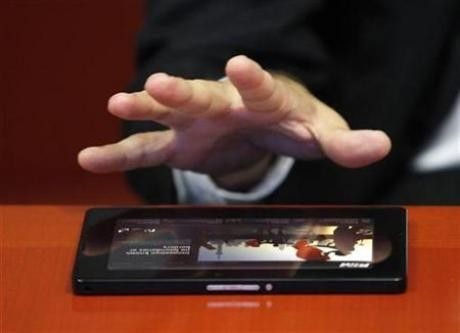Research In Motion upgraded at Jefferies

Jefferies & Co. upgraded its rating of BlackBerry maker Research In Motion Ltd. (RIMM) to 'buy' from 'hold' and increased its price target to $80 from $55, saying QNX operating system is the real deal.
We believe QNX will be a viable platform for carriers and developers and a contender in the operating system (OS) wars. Plus, we believe that international growth will carry RIMM until the new QNX products lauch and that enterprise share loss will likely be slower than the Street fears, said Peter Misek, an analyst at Jefferies.
On April 2010, Research In Motion acquired QNX Software Systems from Harman Kardon, a division of Harman International Industries (HAR). The first version of QNX was released in 1982 and based on Unix.
Before RIMM's acquisition, QNX had mainly been used in embedded systems like real-time flight control systems, high-speed TGV trains in France, the shuttle's space arm, and automotive systems.
A key difference with Android, based on Linux, is QNX's microkernel architecture. Linux uses a monolithic kernel so there is only one size, which is fairly large in order to support all of its features. QNX's microkernel architecture allows for individual parts/features to be turned off or not installed if not needed.
So RIMM can use a very small and feature-light version for low-end phones and the full implementation for tablets. This means that RIMM will be able to use one OS to address the low-end of the market while still adding features for the high end. Android and iOS would need to develop and maintain a separate version for the low end.
In September 2010, Research In Motion announced a tablet computer, the BlackBerry PlayBook, and a new operating system BlackBerry Tablet OS based on QNX to run on the tablet.
Peter Misek said his upgrade is due to: QNX better and earlier than expected, international growth, and enterprise share loss slower than feared.
The new OS provides a great browsing experience, is scalable so can address low end and high end, is easy to port Android applications to, and is more secure, and requires less bandwidth. Also the transition to QNX will be faster than expected, said Misek.
Misek said international growth should carry RIMM until the new QNX products launch. The strength comes from Blackberry Messenger (BBM) as a free texting service and from the launch of a consumer service in China.
Misek said his checks indicate enterprise app stickiness (email-only enterprise users more at risk from share loss due to sandboxing) and non-enterprise app data charges are likely to lead RIMM to only lose 300,000 enterprise subscribers in calendar 2011.
Research In Motion is scheduled to report its third quarter earnings on December 16. Jefferies expects shipments tracking at the very high end of the company's 13.8 million to 14.4 million guidance range.
Bear case on RIMM is that third quarter earnings are near RIMM's peak. Consensus estimates fiscal 2012 EPS only up 3 percent year-over-year followed by a 10 percent decline in fiscal 2013. We do not believe that will be true due to QNX-based product launches in calendar 2011, said Misek.
Overall responses on handset pricing and volumes was very positive. Also, despite poor customer satisfaction responses and market share losses, RIMM handsets are still a high focus of inquiry. Shannon's Law indicates that wireless spectral efficiency limits are likely to be reached in the next decade, putting increased emphasis on bandwidth efficient solutions like RIMM's, Jefferies said in a report to clients.
The brokerage estimate 14.2 million shipments in fiscal third quarter and 14.5 million shipments in fourth quarter, higher than Street estimate of $14 million.
The brokerage raised its 2011 EPS estimate for RIMM to $6.29 from $6.12 and its 2012 estimate to $6.74 from $5.89. We tweak our estimates higher based on stronger shipments for RIMM, said Misek.
With regard to upcoming product launches, Misek said RIM's Playbooks launch likely in February 2011. Misek believes we are not far from a no-tethered Playbook (the first Playbook will be wifi-only but able to tether to other Blackberry devices that have 3G access). Misek expects a about 10-inch version later in 2011.
With regard to phones, Misek said QNX on handsets in labs likely in first quarter and expects 6 touch-screen devices to launch in second half of 2011. Misek had expected a launch of the Storm 3 at Verizon (VZ) this past week, but now believes it is being delayed for QNX.
We expect Storm 3s with QNX to be in the labs imminently. We believe RIM will design their new QNX platform for handsets in a modular way so that no one supplier can delay the transition. We expect possible new content partnerships with MSOs for TV Anywhere with subscriptions. We expect new content deals with Amazon and others, said Misek.
Is RIM Gaining or Losing Share? Jefferies' quarterly survey focused on Research in Motion, Apple Inc. (AAPL), Samsung, Nokia Corp. (NOK) and smartphone industry trends showed that 33 percent of respondents believe that RIM is losing share, an increase of 11 points.
The most noteworthy result was that, despite its poor customer satisfaction responses and market share losses, RIM handsets are still a high focus of inquiry. If RIM maintains a large mindshare and if it launches compelling new products, the results imply that customers still seem willing to buy (unlike, for example, Nokia who has larger image issues), Jefferies report stated.
RIMM closed Monday's regular trading session down 0.35 percent at $58.99 on the NASDAQ stock market. In the after-hours, the stock fell 0.34 percent to trade at $58.79.
© Copyright IBTimes 2024. All rights reserved.





















